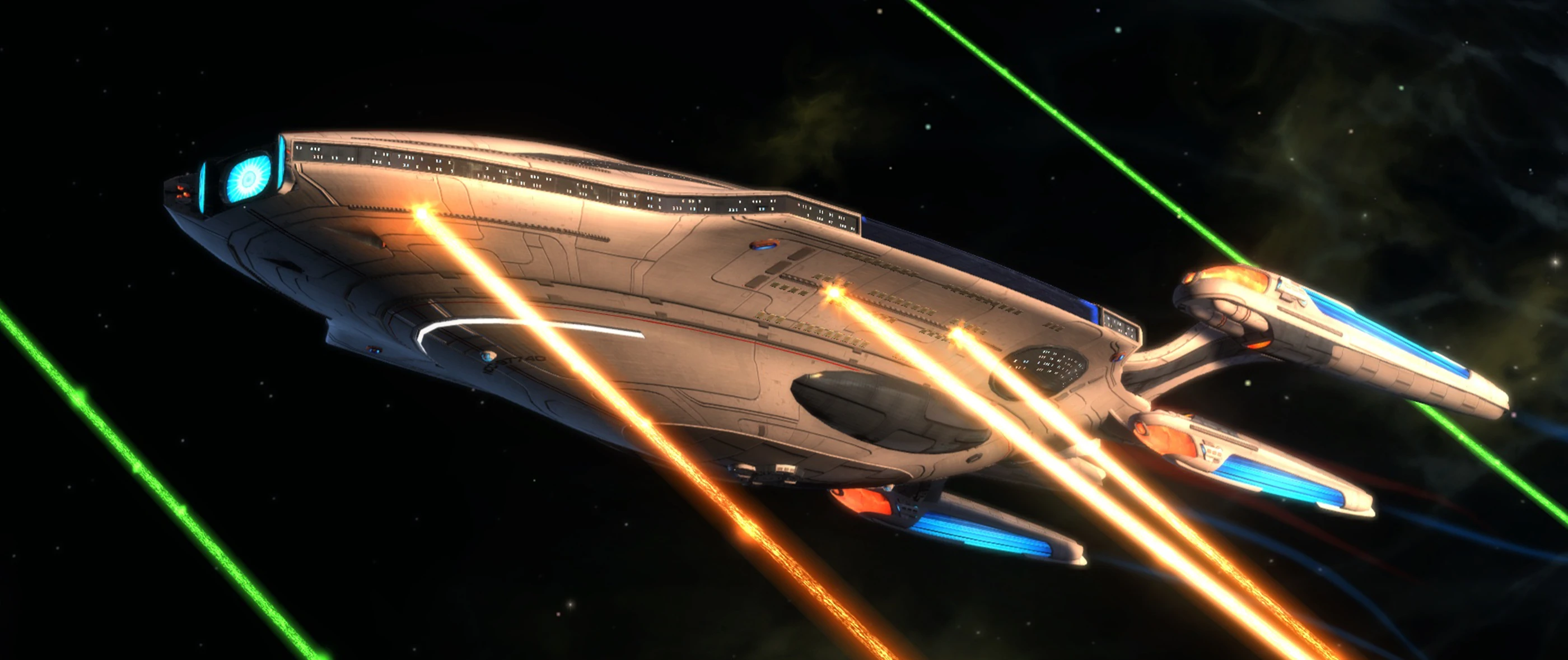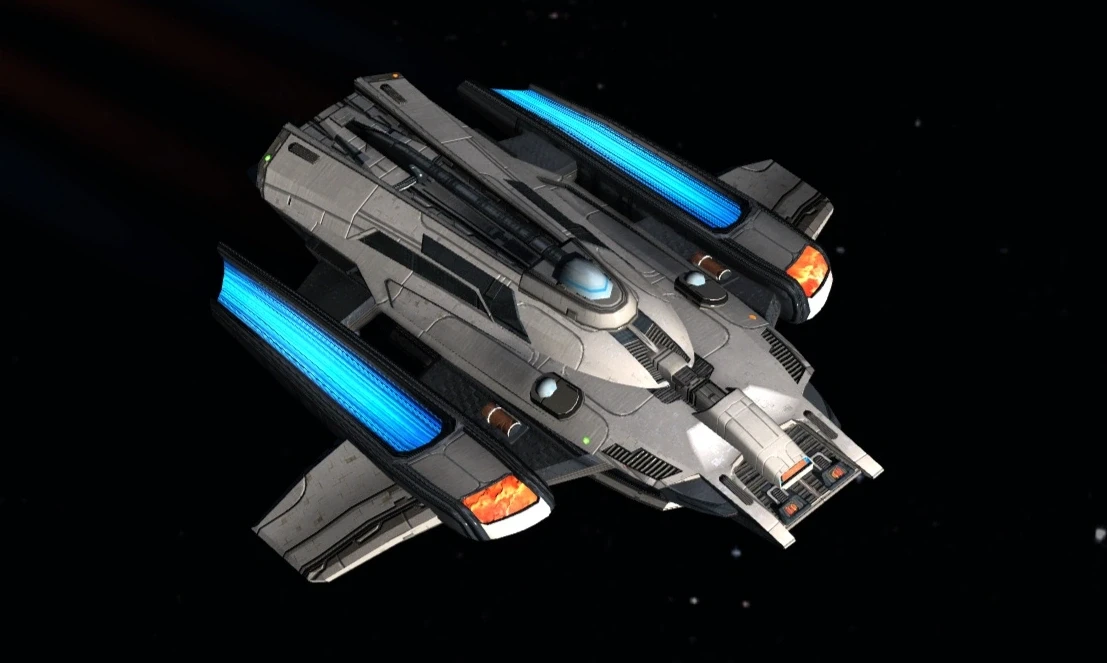U.S.S. Kearsarge
| USS Kearsarge | |
|---|---|

| |
| History | |
|
Namesake: Builder: Homebase: Operator: Registry: Status: |
USS Kearsarge (LHD-3) Utopia Planitia Fleetyards Deep Space 13 Starfleet, 38th Fleet NCC-74820 Active |
| General Characteristics | |
|
Class and Type: |
Jupiter class Carrier |
|
Length: Beam: Draft: Mass: |
1466 m 224 m 535 m 17,000,000 mt |
|
Propulsion: |
3x Yoyodyne 44A M/ARC Warp Core 2x Paired LF-51 Mod 5 Advanced Asynchronous Warp Drive Units 1x Q-1T Quantum Slipstream Drive System 2x Asynchronous TF-5-U Transwarp Coil Units 9x FIG-7 Subatomic Unified Impulse Engines |
|
Avg. Cruise: Max Cruise: Maximum QSS: |
Warp 8 Transwarp 13 Transwarp 32 (2 hours) |
|
Decks: Crew: Capacity.: |
64 3010 50,000 |
|
Sensor Systems: |
20x DYN-75 Multi-Band Linear Sensor Systems 10x Omniwave Passive Sensor Matrices 2x AN/A-27C WATCHER Air Traffic Control Arrays |
|
Defenses: |
FSQ4-K Primary Shield Array with backup FSS-9 Secondary Force Field and Deflector Control System Shinsei Industries G14 Heavy Graviton Navigational Deflector Duranium Ablative Armor |
|
Armaments: |
12x Type-XII Phaser Arrays 48x Phaser Flak/CIWS Turrets 4x Tri-tube Variable-Payload Torpedo Launchers |
|
Auxiliary Craft: |
144x Peregrine or Valkyrie class Strike Fighters 2x Danube or Yellowstone class Runabouts (AEW&C) 2x Danube or Yellowstone class Runabouts (EW) 2x Danube or Yellowstone class Runabouts (Cargo) 3x Argo class Shuttles (with rovers) 8x Type-8 shuttles 4x CMU Workbees |

| |

| |
The USS Kearsarge (NCC-97753) is a Jupiter class carrier in service with the 38th fleet. She is named for the Wasp class Amphibious Assault Ship of the same name from the late 20th, early 21st centuries. She is the fifth Starfleet vessel to bear the name, after a Daedalus class, Constitution class, Miranda class, and Challenger class vessels.
History
Laid down in 2408 at the San Francisco Fleetyards, the USS Kearsarge was launched two years later in mid-2410 from the Utopia Planitia Fleetyards. Kearsarge was immediately dispatched to Deep Space 9, to serve as a deterrent for any hostile forces in the area, such as the Tzenkethi. She participated in the Third Battle of DS9, this being the first time where she launched her entire fighter wing at one time. Despite taking heavy losses from the massive Jem’Hadar force, Kearsarge, and then Carrier Air Wing (CVW)-9, proved their worth in the combat. After this engagement, Kearsarge was recalled back to Utopia Planitia to replace her now understrength fighter wing with CVW-13. She returned to DS9 for the next two years before being reassigned to the newly discovered Solanae Dyson Sphere, to assist in the defence of Alliance Forces from both the Voth and later, the Undine. She stayed in the Dyson Sphere before receiving an emergency recall to Sol when hostilities between the Delta Alliance and the Iconians broke out. Kearsarge participated in the Battle of Midnight, this being the second time that the entire fighter wing has been launched.
After the unexplained ceasefire of that battle, she stayed in the Sol system until Starfleet Command was sure that the Iconians weren’t going to reignite hostilities. After that, Kearsarge was returned to her main AO – DS9 and the Cardassian Border. She assisted in the evacuation of worlds targeted by Tzenkethi protomatter attacks, as well as defending DS9 and Bajor from both the Tzenkethi and then the newly discovered Hurq threat. This was the third, and final time, that Kearsarge has launched her entire air wing, when in combat. After the battle, Kearsarge was one of the few ships in the AO that didn’t head to the Gamma Quadrant to assist the Dominion – rather, she stayed in the Alpha Quadrant to combat the Hurq. At the closure of the Hurq conflict, Kearsarge stayed in the DS9 AO up until 2422, at which point, she was recalled to Sol to rotate and replenish her Carrier Wing. Once this was completed, Kearsarge was reassigned once again, now embarking CVW-7, this time to assist in 38th Fleet operations out of the Aldebaran Sector.
On Stardate 99229.3, Kearsarge was one of a number of ships called up to assist in delaying actions against the Terran fleet and the entity known as The Other. Despite the engagement going exceptionally poorly (see AAR: Operation Roadblock), Kearsarge, alongside the Presidio class USS Alexander were able to retreat from the battle and were recalled to Earth, where both ships participated in the Battle of Jupiter, where both ships were digitized. However, once The Other was pacified, Stardate 99234.3, both ships, alongside everything else that The Other, or C’Qer had digitized were restored. Kearsarge was then assigned briefly to Utopia Planitia to undergo some minor repairs, as well as replenishment of her air wing, before returning to DS13 and resuming her normal duties.
Technical Data
Physical Arrangement & Crew Support
At 1466 meters in length, the Jupiter class carrier is one of Starfleet’s largest vessels. Designed as a response to the KDF’s Vo’Quv and VoD’leh class carriers, the Jupiter class was first launched in 2405, with the breaking down of relations between the UFP and the Klingon Empire. Her design was based on that of the Jupiter class dreadnought, a design which failed miserably, when compared to its newer sibling. As such, the carrier retains the four nacelled design of the previous Jupiter, as well as the combined saucer/engineering hull design.
With a crew complement of 3010, the Jupiter’s crew support is highly efficient. There is one main medical facility in the ship, with 20 smaller stations scattered throughout the ship, as well as provision for up to 10 additional facilities through modular systems. There are also 20 separate Crew Lounges, 10 holodeck and 4 holosuite facilities, and 20 gym suites.
To complement the existing crew, Jupiters have holoprojectors installed on every deck, allowing for Emergency Holograms to be activated when needed. That being said, the ship has capacity for nine EMHs, six Emergency Engineering Holograms, and 20 Emergency Security Holograms.
Tactical & Defensive Systems
Despite her main striking force being the six embarked squadrons of Peregrine class
strike fighters, the Jupiter class is still reasonably well armed, sporting 12 Type-XII Phaser strips, alongside 4 Tri-tube variable payload torpedo launchers. Jupiters are also fitted for dual or quad Pulse Phaser cannons, although these are fitted/removed at the captain’s discretion.
The defensive armament of a Jupiter is nothing to sneer at, however. Her hull is lined with 48 separate Phaser CIWS turrets, capable of wrecking large numbers of hostile fighters. Her deflector shields are some of the strongest in the fleet, even though they have such a large area they need to cover. A Shinsei Industries G14 Heavy Graviton Navigational Deflector provides protection to the ship from space debris while at warp. The last line of defence of the ship, if something manages to get past all these layers of protection is a layer of duranium ablative hull armour covering the entire ship, with extra protection around the bridge and main engineering.
Propulsion
Power for a Jupiter is drawn from three Yoyodyne 44A M/ARC Warp Cores. Combined, these three cores provide enough power to sustain the ship’s enormous shield grid, as well as the vessel’s 2 pairs of LF-51 Mod 5 Advanced Asynchronous Warp Drive Units. Additional Superluminal transport is provided by a Q-1T Quantum Slipstream Drive System and two Asynchronous TF-5-U Transwarp Coil Units, the latter of which were retrofitted onto all ships of the class after the opening of the Khitomer Alliance’s Transwarp Network.
Subluminal travel is provided by nine separate FIG-7 Subatomic Unified Impulse Units. These units have enough power to push the 17 million metric ton vessel up to about .25c. However, because of the class’s enormous mass, a Jupiter class carrier is insanely sluggish at manoeuvring.
C3 (Command, Control, & Communications) Systems
Like all Starfleet vessels, the Kearsarge has her bridge on deck 1. This is a standard Starfleet bridge, with all the major stations ringed around the captain’s chair in the centre. However, unlike most Starfleet vessels, the Kearsarge, and the Jupiter class as a whole, also have a CIC buried deep inside them. This is where the ship’s complement of embarked craft are controlled from, acting as the ship’s aerospace traffic control centre. The ship’s Flight Controllers, Traffic Controllers, and approach/departure controllers operate out of here, monitoring not just the Jupiter’s air wing, but also the auxiliary craft of other ships in the Jupiter’s task group or AO. Jupiters also have an extensive communications suite, enabling this ability to communicate with countless small craft. This suite also makes vessels of the class suitable as fleet/flotilla/task group flagships.
Auxiliary Craft
Currently, the Kearsarge is embarking Carrier Air Wing 7 (CVW-7). This comprises 10 separate squadrons, those being VFA-104, VFA-130, VFA-117, VFA-58, VFA-87, VFA-141, VAW-2, VAQ-67, VRM-34, and HSC-78. The six Strike Fighter squadrons are composed of 24 Peregrine or Valkyrie class fighters each. These are the main striking arm of the vessel. VAW-2 is the ship’s AEW&C squadron. This contains two Danube class runabouts, specially modified for the role. VAQ-67 is the carrier’s Electronic Warfare squadron. Like VAW-2, this squadron contains a pair of Danube class runabouts, modified for the role. VRM-34 is the shipboard heavy cargo squadron. This squadron operates two standard Danube runabouts and three Argo class heavy shuttles. Finally, HSC-78 is the light transport and maintenance squadron. This operates 8 Type-8 shuttles as well as 4 CMU Workbees. If the ship is not carrying its six attack squadrons, Kearsarge can carry 4 separate Callisto class light escort frigates, however this is not standard, and rarely if ever happens.
The reason such a massive air wing is able to be carried is because of the ship’s three separate launching bays – two on the port and starboard sides, and one on the dorsal side. While all three bays are capable of operating simultaneously, during standard operations, only the port and starboard bays are operational. A single bay is also incapable of engaging in launch and recovery operations simultaneously, and as such must confirm with the CIC which operation it is being assigned on a given day. For ease of transport, all three bays connect into the ship’s seven internal hangar bays.
Mission Patches, Battle Honours, and Awards

Jupiter class USS Kearsarge

Carrier Air Wing 7

Taurus Squadron
Solanae Sphere
Undine Campaign
Vaadwaur Campaign
Iconian War
Hur'q Conflict
Terran Incursion
Gallery

Jupiter Class Master Systems Display

Task Force 1, Operation Roadblock - Kearsarge's first outing with the 38th

Kearsarge at warp

Kearsarge and Alexander over Jupiter prior to the Terran's arrival

Kearsarge in drydock after taking a beating in the Battle for Jupiter
